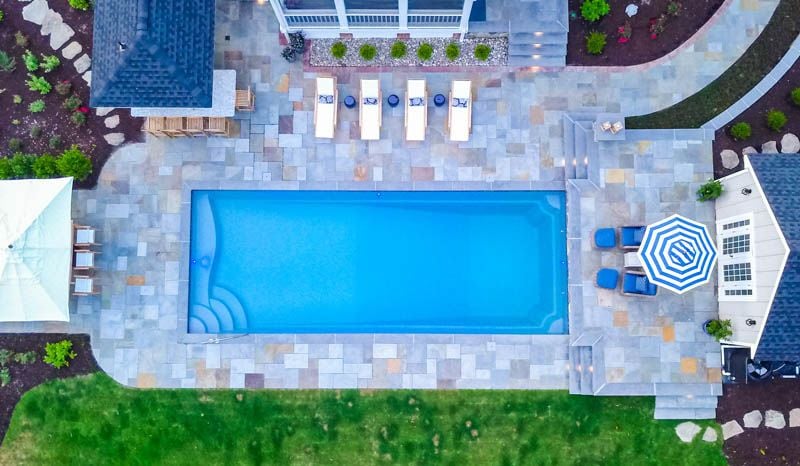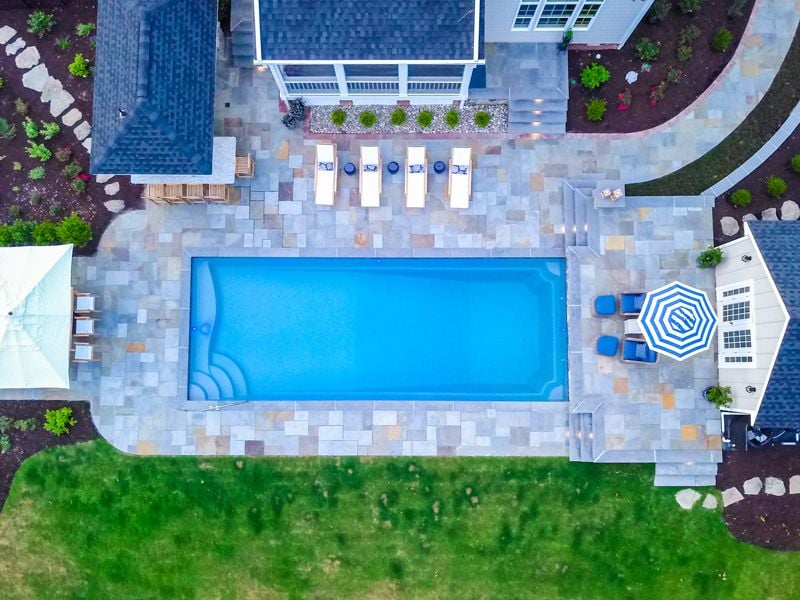
What Is the Life Expectancy of a Fiberglass Pool?
Fiberglass Pool Information | Pool Maintenance
Fiberglass pools are durable, low maintenance, and they have the fastest installation of all inground pools, but you might still be asking, “What is the life expectancy of a fiberglass pool? How long should a fiberglass pool last?"
Great questions.
At River Pools, we specialize in fiberglass swimming pools, so we get these questions all the time. To give you an idea of the expected fiberglass pool lifespan, we decided to write this article explaining how long your pool will last as well as how you can preserve and extend the life of your fiberglass pool.
Let’s dive in.
How long do fiberglass pools last?
A fiberglass pool can last for many decades if it’s a good quality pool. How do you know if your fiberglass pool is good? Two main things: the manufacturer is reputable, and the installation is done properly.
The manufacturer of your pool should use high-quality materials and inspect each pool shell thoroughly before shipping it out. The pool also needs to be installed with precision and care to issues and problems in the future.
See how we install our pools the River Pools Way to keep the pool intact and prevent future problems.
How to maintain your fiberglass pool
The lifespan of your fiberglass pool will also depend on how well you take care of it. This is something that is true for every pool, no matter what kind you have.
One of the most important parts of this is maintaining the chemical balance. Your pool’s pH levels should be between 7.2 and 7.8. The diagram below shows how that compares to normal household items.

Make sure to test these levels regularly and to document your findings because chemical imbalance can harm your pool and your pool equipment. Read more about this in our full guide on testing your pool’s water chemistry.
In addition to maintaining proper water chemistry, you will need to properly filter the pool water by running the pool pump for an adequate amount of time each day and by keeping your filter clean and functioning properly.
Finally, make sure to keep the water in the pool at the right level. In many cases there is water around the outside of the pool shell and lowering the water level could cause enough hydrostatic pressure to potentially harm the pool.
We recommend that you always keep the water level one-third of the way to halfway up the skimmer (the little box on the side that catches debris), and never drain your fiberglass pool. If you need to drain your pool for any reason, consult with a professional first.

See our full guide on proper fiberglass pool maintenance for more details.
How does fiberglass compare to other pool types?
Because concrete pools require more maintenance, many concrete pool customers pay a professional to maintain their pool. They also typically require more chemicals to control algae, require acid washing every 3-5 years, and replastering or otherwise resurfacing every 10-15 years. This can add up to $20,000 to $30,000 very quickly.
If you have a vinyl pool, the vinyl liner typically needs to be replaced every 5-9 years, and that alone costs around $4,500 on top of chemicals, electricity, and other maintenance costs (an additional $7,000).
With fiberglass pools, you pretty much only have to pay for chemicals and electricity, which may cost you around $4,000 total within a 10 year period. Compared to concrete and vinyl liner pools, fiberglass pools cost much less to own and you can do most of the maintenance yourself.
Read our in-depth guide comparing fiberglass, vinyl liner, and concrete pools for more details.
Do fiberglass pools need refinishing?
Maintaining a swimming pool can be hard work. For some people, it’s a full-time job. With fiberglass pools, you’re looking at very minimal maintenance compared to other types of swimming pools.
A fiberglass pool will eventually need to be refinished at least 20 or 30 years old before you see a need for refinishing.
At some point in the future, you might need to retouch or completely refinish your pool’s surface. This is obviously not something that you will do by yourself, so you’re going to have to call in a professional to get this job done.
(Read more about refinishing a fiberglass pool here.)
While refinishing your fiberglass pool won’t be an easy DIY project, let’s put into perspective how much less work that is compared to the other types of pools:
- Concrete pools need acid washing and replastering in less than half that time, which can cost over $10,000.
- Vinyl pool liners are easy to tear and can cost a small fortune to replace (over $4,000).
Meanwhile, most fiberglass pools have a durable gelcoat that can go a few decades without refinishing.
What wear can you expect to see on your fiberglass pool?
While there shouldn’t be any major changes in your pool, the bright color may start to fade (this also depends on the pool color). This is natural considering your pool sits out in the sun. However, the fading is typically very even and gradual, and you probably won’t notice it.
If you purchase the pool from a quality manufacturer, have it installed properly, and take care of it, you shouldn’t have any major issues with your fiberglass pool. However, like all swimming pools, we know that fiberglass pools can encounter unforeseen problems.
To learn more about this, read about the top 5 fiberglass pool problems and how to fix them.
How to extend the life of your fiberglass swimming pool
To give you a quick recap, here are the things that you can do to preserve and extend the life of your fiberglass pool:
- Don’t use any harsh chemicals not made for fiberglass pools
- Keep the pool clean and use a pool cover when necessary
- Maintain the chemicals at the proper levels
- Run the pool filter system and keep the filter clean at least one cycle per day
- Keep the water level about halfway up the skimmer
- Never drain your fiberglass pool

A fiberglass pool is truly your best option if you're looking for a durable, low-maintenance swimming pool with minimal lifetime costs. If you buy a high-quality pool and take care of it properly, it should last many years.
At River Pools, we manufacture world-class fiberglass swimming pools for installation across North America. We have a wide selection of models of all shapes and sizes, including small pools for small backyards and large pools that are over 8 ft. deep.
Check out our pricing guide today, try out our fiberglass pool cost calculator, or request a custom quote to get started.
Before you go, don't forget to download our free ebook below discussing the differences between the three main types of inground swimming pools.
Up Next:
How Much Time Does It Really Take to Maintain a Fiberglass Pool?
How Deep Are Fiberglass Pools?
Ultimate Pool Planning Guide: 11 Things to Consider Before Installing an Inground Pool
Editor's note: This article was originally written by Marcus Sheridan and was updated on November 11, 2024, with current information. River Pools is a brand of inground fiberglass pools produced in a manufacturing facility in Fortville, IN. While our expertise is in manufacturing fiberglass pools, we have access to a network of installers with expertise relating to project design, installation, and pool service. We often tap into this knowledge base and share information freely with homeowners, just like you, considering installing a swimming pool in your backyard.





